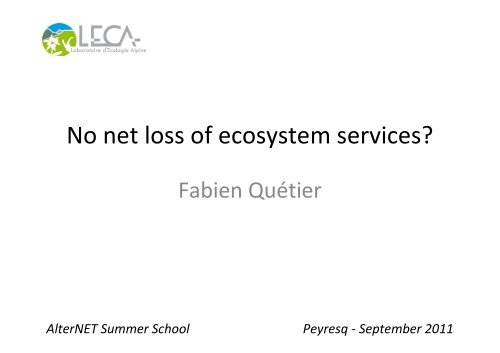You also want an ePaper? Increase the reach of your titles
YUMPU automatically turns print PDFs into web optimized ePapers that Google loves.
<strong>No</strong> <strong>net</strong> <strong>loss</strong> <strong>of</strong> <strong>ecosystem</strong> <strong>services</strong>?<br />
Fabien Quétier<br />
AlterNET Summer School Peyresq - September 2011
Fabien Quétier – Peyresq 2011<br />
Heathlands or chicken?<br />
2
Heathlands over chicken!<br />
• Article 6(3) : alternatives, effects on the “integrity <strong>of</strong><br />
the Natura 2000 site”, “overriding public interest”<br />
(health, security or environment)<br />
• Article 6(4) : residual impacts must be compensated<br />
for… in advance <strong>of</strong> impacts, with demonstrated<br />
additionality<br />
Fabien Quétier – Peyresq 2011<br />
<strong>No</strong> Net Loss<br />
3
Fabien Quétier – Peyresq 2011<br />
The mitigation hierarchy<br />
Avoid impacts<br />
Reduce impacts<br />
Offset residual impacts<br />
4
Is everything “worth” <strong>of</strong>fsetting?<br />
I mean… a swamp is a<br />
swamp… right?<br />
How do you create<br />
habitat for middle-aged<br />
great blue herons who<br />
don’t like shrimps??<br />
Adapted from Roberston 2004 Ge<strong>of</strong>orum<br />
5
Is it technically<br />
feasible to restore<br />
lost components <strong>of</strong><br />
biodiversity and<br />
<strong>ecosystem</strong>s?<br />
The mitigation hierarchy<br />
What types <strong>of</strong><br />
alternatives<br />
should be<br />
considered?<br />
Fabien Quétier – Peyresq 2011<br />
Avoid impacts<br />
Reduce impacts<br />
Offset residual impacts<br />
Which<br />
components <strong>of</strong><br />
biodiversity and<br />
<strong>ecosystem</strong>s are<br />
covered ?<br />
How do you<br />
measure <strong>loss</strong>es<br />
and gains?<br />
Governance: liabilities,<br />
monitoring, expertise, funding?<br />
6
Fabien Quétier – Peyresq 2011<br />
<strong>No</strong> Net Loss<br />
7
• Identifying <strong>ecosystem</strong><br />
<strong>services</strong><br />
• Selecting a measure <strong>of</strong><br />
<strong>ecosystem</strong> service<br />
delivery<br />
• Assessing <strong>loss</strong>es<br />
(present and future)<br />
• Assessing gains<br />
(past and future)<br />
• Taking into account<br />
uncertainty<br />
Technical issues<br />
8
• Identifying <strong>ecosystem</strong><br />
<strong>services</strong><br />
• Selecting a measure <strong>of</strong><br />
<strong>ecosystem</strong> service<br />
delivery<br />
• Assessing <strong>loss</strong>es<br />
(present and future)<br />
• Assessing gains<br />
(past and future)<br />
• Agreeing on an<br />
acceptable level <strong>of</strong> risk<br />
Value issues !<br />
What should we do when<br />
we can’t actually restore<br />
the impacted biodiversity<br />
or <strong>ecosystem</strong>s?<br />
9
Offsetting through preservation<br />
10<br />
Gibbons & Lindenmayer 2007 Ecol. Rest. & Mngt.
Offset ratios<br />
3 for 1 (area) ratio<br />
11
Offset ratios<br />
A 3 for 1 ratio means<br />
you accept to lose<br />
25% <strong>of</strong> the remaining<br />
unprotected habitat<br />
12
Ratios <strong>of</strong> acceptable <strong>loss</strong><br />
Critical Natural Capital<br />
- Irreplaceable (unrestorable<br />
components <strong>of</strong> biodiversity and<br />
<strong>ecosystem</strong>s<br />
A 3 for 1 ratio means<br />
you accept to lose<br />
25% <strong>of</strong> the remaining<br />
unprotected habitat<br />
13
Ratios <strong>of</strong> acceptable <strong>loss</strong><br />
Critical Natural Capital<br />
- Irreplaceable (unrestorable<br />
components <strong>of</strong> biodiversity and<br />
<strong>ecosystem</strong>s<br />
A 3 for 1 ratio means<br />
you accept to lose<br />
25% <strong>of</strong> the remaining<br />
unprotected habitat<br />
14
Humans depend on<br />
ecological processes:<br />
critical natural capital<br />
<strong>No</strong> <strong>net</strong> <strong>loss</strong> <strong>of</strong> critical<br />
natural capital<br />
1. Identify critical elements<br />
2. Set thresholds<br />
3. Avoid going beyond the<br />
thresholds<br />
4. Offset any <strong>loss</strong>es through<br />
restoration<br />
Two paradigms?<br />
Ecosystems provide<br />
benefits to humans :<br />
<strong>ecosystem</strong> <strong>services</strong><br />
ES trade-<strong>of</strong>fs and<br />
synergies<br />
1. Identify ES<br />
2. Quantify ES<br />
3. Value ES<br />
4. Cost-benefit analysis<br />
5. Maximize well-being<br />
15
<strong>No</strong> <strong>net</strong> <strong>loss</strong> <strong>of</strong> critical<br />
natural capital<br />
Two paradigms?<br />
ES trade-<strong>of</strong>fs and<br />
synergies<br />
16
Nested decision making frameworks?<br />
<strong>No</strong> <strong>net</strong> <strong>loss</strong> <strong>of</strong> critical<br />
natural capital<br />
ES trade-<strong>of</strong>fs and<br />
synergies<br />
17
Any thoughts?
The mitigation hierarchy in France<br />
• 1976 : Loi de protection de la nature<br />
• 1992 : Loi sur l’eau<br />
• 2001 : Les défrichements<br />
• 2004 : Évaluation des plans et programmes +<br />
directive cadre sur l’eau<br />
• 2006>08 : Mise en conformité avec la directive<br />
habitats (dont dérogation espèces protégées)<br />
• 2008 : Loi de responsabilité environnementale<br />
• 2010 : Reforme de l’étude d’impact 19
Habitat banking in France
Service to service equivalence<br />
under US NRDA
Service to service equivalence<br />
Level <strong>of</strong><br />
service<br />
under US NRDA<br />
Temporary <strong>loss</strong>es<br />
Impact Start <strong>of</strong> primary<br />
restoration<br />
Baseline<br />
Natural regeneration<br />
Back to baseline through<br />
restoration<br />
� Time<br />
Adapted from Bas & Gaubert (2010)<br />
22
Offsetting temporary <strong>loss</strong>es<br />
Level <strong>of</strong><br />
service<br />
Restoration<br />
target<br />
au<br />
Service<br />
gain<br />
Impact Start <strong>of</strong> project Target<br />
reached<br />
Time<br />
Adapted from Bas & Gaubert (2010)<br />
23
HEA and REA methods<br />
HEA<br />
Habitat Equivalence Analysis<br />
REA<br />
Resource Equivalence Analysis<br />
24
The HEA and REA methods<br />
• A single indicator <strong>of</strong> service level � proxy selection<br />
• A baseline <strong>of</strong> service level but for the impact and <strong>of</strong>fset<br />
• A forecast <strong>of</strong> post-impact and post-<strong>of</strong>fset service-level<br />
• Calculation <strong>of</strong> gains and <strong>loss</strong>es on a per-year basis<br />
• Discounting factor for long term gains and <strong>loss</strong>es<br />
� Discounted service per area per year (DSAY)<br />
Service level (%) Average service<br />
year Start End<br />
level (%)<br />
Average service<br />
<strong>loss</strong>es (%)<br />
Discount factor Area<br />
(ha)<br />
Losses<br />
(DSAYs)<br />
25

















